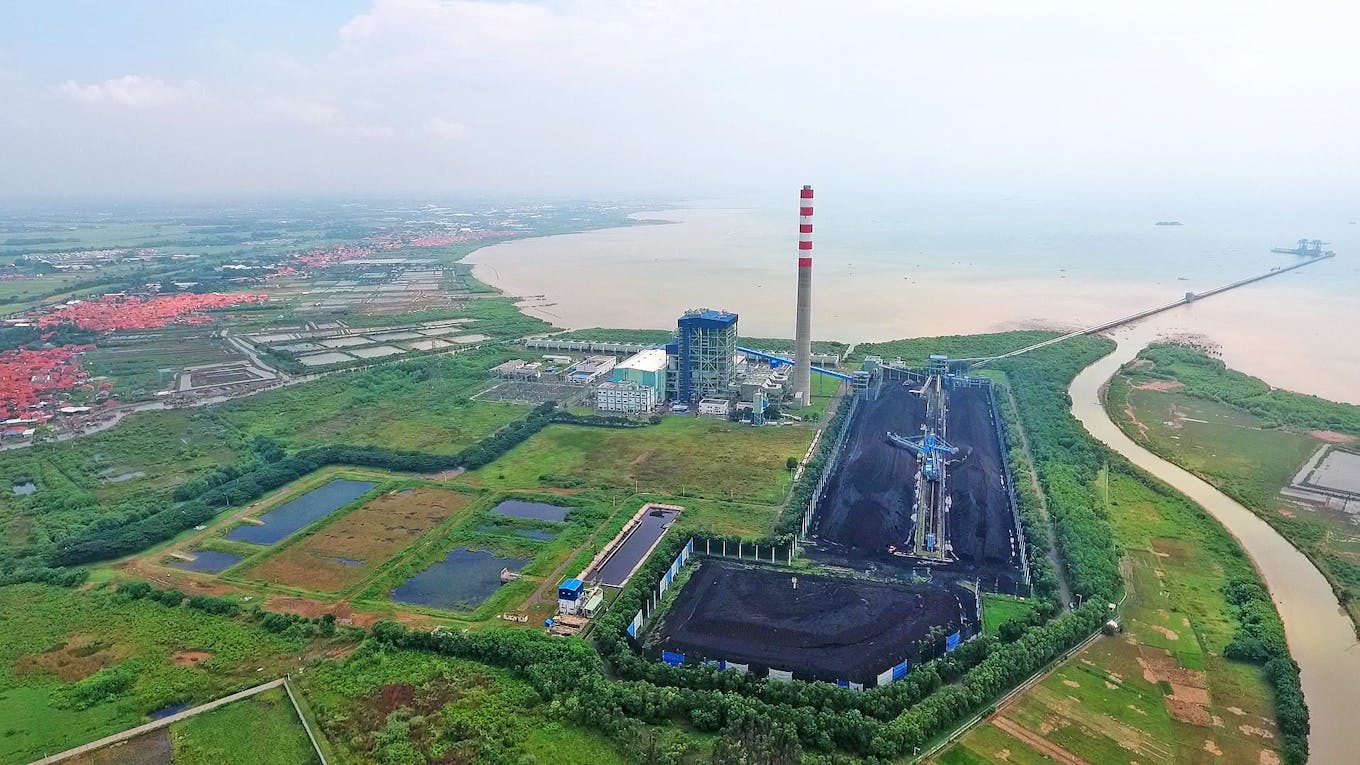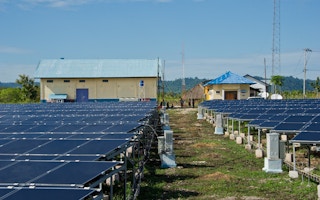Nearly two years after Indonesia’s multibillion-dollar Just Energy Transition Partnership (JETP) mechanism was launched to much fanfare, none of the pledged US$21.6 billion in energy transition financing from rich countries has translated into new clean energy projects or the early retirement of coal-fired power plants.
According to the country’s JETP Secretariat, 19 programmes totalling US$144.6 million were recently launched or are undergoing discussion as of end-June 2024. A check by Eco-Business, however, showed that these programmes, funded by countries including the United States, Canada and Germany, are largely grants for feasibility studies or technical assistance.
“Indonesia has these investment plans that list a bunch of projects, [but those] projects don’t necessarily mean investments [are happening],” said Grant Hauber, strategic energy finance advisor for Asia at the Institute for Energy Economics and Financial Analysis (IEEFA).
One key planning document in relation to JETP and Indonesia’s energy transition is the Comprehensive Investment and Policy Plan (CIPP), published in 2023 by the JETP Secretariat. While the plan has been criticised for not excluding coal-fired integrated power plants in industrial areas and for ignoring community-based clean energy projects over large scale ones, it also lays out the country’s most ambitious targets for the renewables in Indonesia’s energy mix by 2050 [see Figure 1].
Putu Indy Gardian, the JETP Secretariat’s technical specialist, said that these ambitious targets were set to spur various government ministries and even Perusahaan Listrik Negara (PLN), Indonesia’s state-owned power utility, in aligning their renewable energy targets, which have historically been mismatched, with Indonesia’s decarbonisation targets. The country’s recently updated Nationally Determined Contribution targets a 32 per cent reduction in emissions by 2030 without international aid, and 43 per cent with international aid.
However, it is up to the government to decide whether the CIPP’s more ambitious scenario will translate into national policy changes and mechanisms, said Gardian. Indonesia will see Prabowo Subianto take over the country’s presidency from Joko Widodo later this month, on 20 October, and the current Renewable Energy Bill will be passed on to his administration to pass into law. Critics consider the bill underwhelming.
“Looking at Indonesia’s renewable energy bill that will be enacted later this year, it is quite bleak because it categorises new energy as possibly fossil fuel-derived energy” said Dinita Setyawati, senior electricity policy analyst at independent think tank Ember. “There’s not much emphasis placed on renewables [such as] solar and wind.”
And yet, a crucial part of CIPP is an exponential rise in solar photovoltaic capacity from 100 megawatts in 2022 to 4.1 gigawatts (GW) in 2025 – an increase of more than 40 times. The rate of renewables capacity addition is expected to increase seven times by 2030, to 29.3GW, and will reach 264.6GW by 2050. [see Figure 2]
“How [is Indonesia going to achieve that]? What policies and process mechanisms will make that happen?” Hauber asked at IEEFA’s recent Energy Finance 2024 conference, where Gardian also spoke. Several experts at the event shared their thoughts with Eco-Business on practical steps Indonesia can take to finance its energy transition.
Solution 1: ‘Tender factory’ needed
When it comes to the CIPP’s renewables targets, what is needed is for “dozens of projects to be cranked out almost like a factory process,” said Hauber. Each solar project, for instance, requires multiple factors to succeed – from physical needs like an appropriate site and transmission interconnections, to ensuring there are rigorous contracts, pricing mechanisms and a bidding process that often takes months, if not years.
This “tender factory”, a specialised unit that would identify, plan and execute projects, is currently missing from JETP, he said. “This kind of work is boring – that’s the reason [for the sluggishness].”
However there is “absolutely no shortcut” for having to do tender designs and consulting with stakeholders including lawyers, bankers and engineers, he said. “This has been the bugbear of all infrastructure development in Asia for years – [there] is high ambition and high policy targets but low implementation capability.”
However, Indonesia does not need to reinvent the wheel – there are domestic and regional examples of government agencies which oversee public-private partnership (PPP) projects that have worked well in the past, said Hauber. One example is PT Sarana Multi Infrastruktur (Persero, or PT SMI), which is a special mission vehicle under Indonesia’s Ministry of Finance. Persero has financed more than 400 infrastructure projects since its inception 15 years ago, but has only recently been tasked with supporting energy transition projects under the country’s energy transition mechanism.
Another example of a successful operation is the Philippines’ PPP Center, which has gone from having just two people and no projects in 2000 to over 200 staff and nearly 100 operating projects today, said Hauber.
Solution 2: Liberalising the market
PT SMI’s ability to get more renewable energy projects off the ground, however, is limited by existing contracts for coal-fired power plants, managed by PLN, which monopolises Indonesia’s electricity supply. Coal is Indonesia’s primary source of energy, making up 36.4 per cent of the energy mix in 2030, according to International Energy Agency data. Energy-related emissions stood at 652 million tonnes of carbon dioxide and its equivalents (MtCO2e) in 2022, or 1.91 per cent of global emissions.
Steps are being made at a national level to address this. Indonesia’s government announced in August that it is planning to shut down or decommission 13 of its coal-fired power plants, which have a total capacity of 4.8 GW and generate 66 MtCO2e. Some of these are old plants that are scheduled to retire naturally, said the director general of Indonesia’s Energy and Mineral Resources Ministry, Eniya Listiani Dewi.
Meanwhile, PLN announced last month that it would be switching 800 of its coal-fired power plants to gas by 2060. It has yet to announce details of which plants would be closed and when.
One way to speed up the transition is for Indonesia to loosen PLN’s monopoly on the electricity market by allowing for third parties to buy and sell renewables, said Hauber. Other Southeast Asian countries have already begun doing this – PLN’s counterpart in Vietnam, EVN, also held a similar monopoly over electricity generation and transmission until the government announced in July that direct power purchase agreements (DPPA) would be allowed. Malaysia also recently granted third-party access to the electricity grid by large companies looking to buy renewable energy directly from producers, although industry players say more needs to be done.
“What I’m hopeful for is that Vietnam’s DPPA is going to show the way [for an energy market] that can almost be fully private,” said Hauber.

The 600-megawatt Cirebon 1 coal power plant in West Java, Indonesia. The Asian Development Bank is leading efforts to close this unit 10 to 15 years early. Progress on early coal retirement has been slow, due to the difficulty of drafting feasible financing packages. Image: ResponsiBank Indonesia.
In the meantime, PLN does not have to wait on JETP funds to accelerate its energy transition, said Ember’s Setyawati. “Bolder commitment from PLN can happen parallel to JETP developments,” she said.
The state utility is already in the process of a pilot project to decommission coal-fired power plant Cirebon 1 with the support of the Asia Development Bank’s Energy Transition Mechanism, which had been arranged separate from the launch of JETP.
In fact, Setyawati believes that JETP currently plays only a complementary role to Indonesia’s broader energy transition plans. “I think JETP financing helps initially with decarbonisation scenarios, prioritisation of renewables and making data available for the electricity sector,” she told Eco-Business. However, other types of financing can and should be disbursed “parallel with JETP” to avoid an inefficient use of funds.
“For instance, we don’t need multiple feasibility studies on one project,” she said. “The phase out [of coal-fired power plants] will happen gradually, but the great thing is that discussions and awareness of the energy transition is now everywhere.”
Solution 3: Rerouting subsidies
Another stumbling block for Indonesia’s JETP has been the lack of favourable financing terms. Concessional loans from multilateral development banks typically offer more favourable interest rates than commercial loans, and can therefore attract much larger amounts of private capital, said Shantanu Srivastava, research lead for sustainable finance and climate risk at IEEFA.
However, these kinds of loans are not currently being structured and offered as part of Indonesia’s JETP programme, he said.
“That is why the whole JETP programme has been questioned. If [the G7 countries] are providing loans with commercial terms, that does not solve the problem [of inaccessible finance],” said Srivastava.
But another source of funding which could be more catalytic in financing Indonesia’s energy transition is public finance, said Anissa Suharsono, energy policy associate at the International Institute for Sustainable Development (IISD), an independent think tank. This includes subsidies, investments from state-owned enterprises, as well as loans from public financial institutions such as state-owned banks, she said.
“These funds are all under government control and should have been the first to move because it would signal the government’s commitment in transitioning [towards cleaner energy],” said Suharsono. “[Such a signal] plays a crucial role in derisking clean energy investments and eventually attracting a larger volume of private investments.”
Indonesians have already benefited from such a “subsidy swap”, which involves taking funds that are currently used to subsidise fossil fuels and using them to subsidise renewable energy development instead. Suharsono pointed at how in 2015, the government reaped about 276 trillion rupiah (US$20.4 billion) in savings from reforming fossil fuel subsidies. A study by IISD found that this led to more finance being committed to social protection and infrastructure development, including programmes for education, health insurance, housing and clean water.
Banking on the government
Ultimately, JETP must pave the way for a more coordinated response to Indonesia’s energy transition, said Aditya Lolla, Asia programme director at Ember. “If you look at deals like JETP, they are very top down – similar to the rest of policymaking in Asia,” he said.
This forces the “entire machinery” of civil service, the private sectors and investors scramble to deliver on top line targets set by politicians, he added. “It can be a good or bad thing, but when you’re talking about the urgency [of climate action], mechanisms need to become more holistic and coordinated.”
Strong government leadership will also be crucial in driving private capital. “The challenge in most Southeast Asian countries is that the private sector won’t move unless they know the money will flow,” said Hauber. “If companies are waiting for permission from the government or some contract to be negotiated, that’s a delay risk. Delays add cost and uncertainty,” he said.
“The biggest thing [governments] can do is to remove uncertainty – create standard, replicable templates that are predictable. That is what Indonesia is lacking,” said Hauber.










